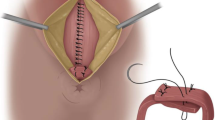Abstract
Purpose
The aim was to evaluate the effects of anterior sphincter repair on faecal incontinence and quality of life.
Patients and methods
Fifty-six patients who underwent anterior anal sphincteroplasty between January 2003 and December 2005 were asked to complete questionnaires containing the Wexner Incontinence Score (a score of 0 corresponds to full continence and 20 to total incontinence) and Faecal Incontinence Quality of Life Scale preoperatively, in May 2006 (mean follow-up time, 22.8 months) and in August 2011 (mean follow-up time, 89.3 months). Thirty-nine (69.6 %) patients completed the questionnaires before the operation and in 2006, and 36 (64.3 %) in 2011.
Results
The overall severity of faecal incontinence improved in 26 patients (67 %), and quality of life improved in 2006 as a whole, but after a longer follow-up (in 2011), the severity of faecal incontinence was about the same as preoperatively (median, 12.0 months) in all the patients. Among younger patients (≤50 years), the situation was better, but older patients (>50 years) had an even worse situation than before the operation. In the group of younger patients, the preoperative median of the overall incontinence score was 10.5, and in 2011, it was 9.0, while in the group of older patients, the corresponding numbers were 13.0 and 15.0. In 2011, quality of life was still better than preoperatively as a whole, but the results had deteriorated from those in 2006.
Conclusions
Initially, both overall faecal incontinence and quality of life improved, but younger patients achieved a greater benefit. However, the results deteriorated with a longer follow-up. Operative management should be considered preferably in relatively young subjects as their results are better.





Similar content being viewed by others
References
Brown SR, Wadhawan H, Nelson RL (2010) Surgery for fecal incontinence in adults (review). The Cochrane Library 2010, Issue 9
Aitola P, Lehto K, Fonsell R, Huhtala H (2010) Prevalence of faecal incontinence in adults aged 30 years or more in general population. Color dis 12:687–691
Bharucha A, Zinmeister A, Locke R, Schleck C, McKeon K, Melton J (2006) Symptoms and quality of life in community women with fecal incontinence. Clin Gastroentrol Hepatol 4:1004–1009
Crowell M, Schettler V, Lacy B, Lunsford T, Harris L, DiBaise J, Jones M (2007) Impact of anal incontinence on psychosocial function and health-related quality of life. Dig Dis Sci 52:1627–1631
Khaikin M, Wexner SD (2006) Treatment strategies in obstructed defecation and fecal incontinence. World J Gastroenterol 12:3168–3173
Dudding T, Pares D, Vaizey C, Kamm M (2010) Sacral nerve stimulation for the treatment of faecal incontinence related to dysfunction of the internal anal sphincter. Int J Color Dis 25:625–630
Mevik K, Norderval S, Kileng H, Johansen M, Vonen B (2009) Long-term results after anterior sphincteroplasty for anal incontinence. Scand J Surg 98:234–238
Parks AG, MacPartlin JF (1971) Late repair of injuries of the anal sphincter. Proc R Soc Med 64:1187–1189
Jorge JM, Wexner SD (1993) Etiology and management of fecal incontinence. Dis Colon Rectum 36:77–97
Rockwood TH, Church JM, Fleshman JW, Kane R, Mavrantonis C, Thorson AG, Wexner SD, Bliss D, Lowry AC (2000) Fecal incontinence quality of life scale. Quality of life instrument for patients with fecal incontinence. Dis Colon Rectum 43:9–17
Rasmussen O, Puggaard L, Christiansen J (1999) Anal sphincter repair in patients with obstetric trauma. Age affects outcome. Dis Colon Rectum 42:193–195
Trowbridge E, Morgan D, Trowbridge M, Delancey J, Fenner D (2006) Sexual function, quality of life, and severity of anal incontinence after anal sphincteroplasty. Am J Obstet Gynecol 195:1753–1757
Gutierrez A, Madoff R, Lowry A, Parker S, Buie D, Baxter N (2004) Long-term results of anterior sphincteroplasty. Dis Colon Rectum 47:727–732
Barisic G, Krivokapic Z, Markovic V, Popovic M (2006) Outcome of overlapping anal sphincter repair after 3 months and after mean of 80 months. Int J Color Dis 21:52–56
Maslekar S, Gardiner A, Duthie G (2007) Anterior anal sphincter repair for fecal incontinence: good longterm results are possible. J Am Coll Surg 204:40–46
Vaizey C, Norton C, Thorton F, Nicholls J, Chir M, Kamm M (2004) Long-term results of repeat anterior anal spincter repair. Dis Colon Rectum 47:858–863
Pinta T, Kylänpää-Bäck M-L, Salmi T, Järvinen HJ, Luukkonen P (2003) Delayed sphincter repair for obstetric ruptures: analysis of failure. Color Dis 5:73–78
Melenhorst J, Koch SM, Uludag Ö, van Gemert WG, Baeten CG (2007) Is a morphologically intact anal sphincter necessary for success with sacral nerve modulation in patients with faecal incontinence? Color Dis 10:257–262
Brouwer R, Duthie G (2010) Sacral nerve neuromodulation is effective treatment for fecal incontinence in the presence of a sphincter defect, pudendal neuropathy, or previous sphincter repair. Dis Colon Rectum 53:273–278
Ratto C, Litta F, Parello A, Donisi L, Doglietto GB (2010) Sacral nerve stimulation is a valid approach in fecal incontinence due to sphincter lesions when compared to sphincter repair. Dis Colon Rectum 53:264–272
Author information
Authors and Affiliations
Corresponding author
Rights and permissions
About this article
Cite this article
Lehto, K., Hyöty, M., Collin, P. et al. Seven-year follow-up after anterior sphincter reconstruction for faecal incontinence. Int J Colorectal Dis 28, 653–658 (2013). https://doi.org/10.1007/s00384-013-1663-3
Accepted:
Published:
Issue Date:
DOI: https://doi.org/10.1007/s00384-013-1663-3




